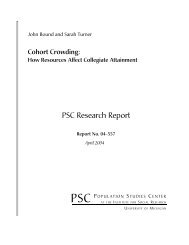Activities, United Nations <strong>Population</strong>Division, U.S. Agency forInternational Development, U.S.Department <strong>of</strong> Commerce, U.S.Department <strong>of</strong> Labor, U.S. Department<strong>of</strong> State, The World Bank,World Health Organization.<strong>Michigan</strong> has always beenstrongly associated with the use<strong>of</strong>survey data in population analysis.This is partly a result <strong>of</strong> the presenceat <strong>Michigan</strong> <strong>of</strong> the strongSurvey Research <strong>Center</strong> (SRC).Some members <strong>of</strong> our staff havelong been associated with the SRC.The first national survey <strong>of</strong> fertilityand family planning was done at<strong>Michigan</strong> in1955 and paved theway for similar studies both in theUnited States and abroad. TheDetroit Area Study, which hastrained many PSC and other studentsin survey research methods,was begun by a staff with strongpopulation interests. The continuing(25 year) longitudinal DetroitFamily Growth Study, recently ledby Arland Thornton and DeborahFreedman, had its first round as aDetroit Area Study under thedirection <strong>of</strong> David Goldberg andRonald Freedman about the time thePSC was founded.While survey work continues tobe important, PSC research is by nomeans limited to that genre. Fromthe beginning the "bread andbutter" sources for demographicwork —the census and registrationdata — have been utilized in much<strong>of</strong> our research. The rapidly emergingmethods and resources <strong>of</strong>historical demography were exploitedearlier in our history byRonald Lee, Paul Demeny, andmore recently by John Knodel. Theuse <strong>of</strong> life-history calendars andframeworks for survey work isgaining prominence among our staffin the work <strong>of</strong> Arland Thornton,Deborah Freedman, and KarenMason. Such less formal approachesas the focused interviewhave been used in a noteworthyway by John Knodel in his work onThailand.The work <strong>of</strong> the <strong>Center</strong> in anumber <strong>of</strong> LDCs led at a fairly earlypoint to the beginning <strong>of</strong> comparativework cooperatively with others.In the late 1960s and early 1970s,Baron Moots, Lolagene Coombs,and Ronald Freedman were members<strong>of</strong>the Organization <strong>of</strong> DemographicAssociates, a group <strong>of</strong> Asianand American scholars who tried tocompare studies on demographictopics not originally designed forcomparative purposes. Similarefforts to compare fertility surveyswere the basis for the early work <strong>of</strong>the IUSSP Comrnittee on the Com-parative Analysis <strong>of</strong> Fertility, inwhich members <strong>of</strong>the PSC staffplayed leading roles.It is consistent with this traditionand earlier work on the communitylevel that leadership in the development<strong>of</strong> formal models relatingmacro and micro-level data acrossregions, communities, and countriesshould have been exercised at<strong>Michigan</strong> by William Mason, AlbertHermalin, and Barbara Entwisle.While fertility research has beenan important form <strong>of</strong> work, therewas always research on the otherbasic demographic processes andproblems. More recently WilliamFrey has strengthened our work onmigration and urbanization. BarbaraAnderson has introduced workon the U.S.S.R. and strengthenedour capabilities in indirect estimation.Reynolds Farley has for manyyears led distinguished work on theblack population <strong>of</strong> the U.S.,as wellas on urbanization. Karen Masonhas worked on research on genderrelatedissues.From early in its history, the<strong>Center</strong> has included economic aswell as social demographers,beginning with Ronald Lee and PaulDemeny. Eva Mueller and DeborahFreedman, who have been on the<strong>Center</strong> staff for many years, willsoon be retiring. David Lam joinedthe staff several years ago. We havehad a succession <strong>of</strong> excellentgraduate students from the Department<strong>of</strong> Economics.An important element inthe development<strong>of</strong> the <strong>Center</strong> has been anexcellent supporting staff. Programmers,secretaries, librarians, researchand editorial assistants, andadministrative staff who haveworked for any sustained periodhave assimilated the high standardswhich have been the goal <strong>of</strong> the<strong>Center</strong>.Research Associates and Post-Doctoral Fellows have played anRonald Freedman 41
important role in the research productivity<strong>of</strong> the <strong>Center</strong>. While theseare too numerous to list, 1 do wantto note Lolagene Coombs, who formany years was my principal collaboratorboth in research on U.S.fertility and on Taiwan's population.What <strong>of</strong> the future <strong>of</strong>the <strong>Center</strong>?A note <strong>of</strong> optimism for the nearterm is justified by the fact that the<strong>Center</strong> is probably at a historicalhigh point in productivity, recognizedleadership in the field, and resources.I can make such a boldstatement without immodesty, sincethe achievements <strong>of</strong>the period from1972to <strong>1987</strong> have been made underthe leadership <strong>of</strong> Albert Hermalinand David Goldberg, following myretirement as Director. Since July<strong>1987</strong>, The <strong>Center</strong> has had anothercapable director, William Mason.The recognition <strong>of</strong> the status <strong>of</strong> the<strong>Center</strong> by its peers is evident in therenewal in1986 <strong>of</strong> its major institutionalsupport grant from theNational Institute for Child Healthand Human Development, a renewal<strong>of</strong> the grant from the HewlettFoundation, and the substantialfunding <strong>of</strong> peer-reviewed grants to•members <strong>of</strong> the PSC staff.It is an intrinsic part <strong>of</strong> a centerlike ours thatthe research andteachingstaff are under heavy timepressures, especially in view <strong>of</strong> thetime and energy needed for traveland field work. The future strength<strong>of</strong> the <strong>Center</strong> will depend on ourability to have enough highlyqualified personnel tomeet all <strong>of</strong> the<strong>Center</strong>'s obligations, especially forcontinuing interaction with studentsin residence.The basic principles and emphaseson which the <strong>Center</strong> wasfounded appear still tobe operatingand valid. We are likely tobe moreinvolved in cooperative work withcolleaguesat other institutionsathome and abroad, because thenetwork <strong>of</strong> people and the communicationsystems to make thispossible and the size <strong>of</strong> data setshave all been growing, in partthrough our efforts. Our owngrowing data archives are animportant resource for this growingworldwide network. The long-termfuture <strong>of</strong>the <strong>Center</strong>, as inthe past,depends on the quality <strong>of</strong> the staffand students, rather than on facilitiesand equipment. Resources willflow to excellent people working byhigh standards and with personalintegrity.The politics <strong>of</strong> population policyand frequent reports on populationmatters are day-to-day headlinesand media events that were definitelynot the case when the <strong>Center</strong>began. These engage our emotionsand may affect funding and dataaccess in some areas in the nearfuture. My guess is thatthesepossible short-run problems will notprevail in the long run, becausesocial policies, whether liberal orconservative, whether federal orlocal, inevitably involve demographicparameters. Inthe long runthe cumulative result <strong>of</strong> the dailyfacts <strong>of</strong> birth, death, and migrationwill outweigh short-run politicalnews and will demand attention inour world <strong>of</strong> growing interdependence,across ideological lines.— Ronald FreedmanNovember <strong>1987</strong>42 <strong>Population</strong> <strong>Studies</strong> <strong>Center</strong>















